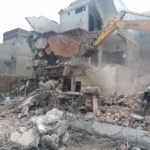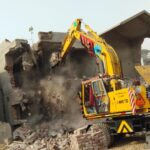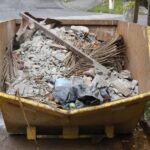Introduction
In the world of building and making cities better, there are different ways to change the way things look. One important way is called “building demolition.” This means taking buildings apart on purpose to make room for new things, reuse the land, or get rid of unsafe buildings. However, now there’s another way that’s good for the environment – it’s called “building deconstruction.” This friendly-to-nature way is about carefully taking apart buildings to save and use the materials again. This helps make less waste and is better for the Earth.
This article talks about how building demolition and building deconstruction are different. Additionally, it looks at the special ways each one works, like breaking down the structure and concrete.
What is Building Demolition?
Taking down and taking apart buildings play a crucial role in the world of building and improving cities. People do this a lot in the construction and city development field. First, there are two main ways we do this – building demolition and deconstruction. These things have important jobs in changing how places look and work.
We break down big structures, homes, or concrete buildings to make new things and use spaces in new ways. First, building demolition is when we purposely take apart or destroy buildings to make room for something new. Second, we reuse the land and get rid of unsafe buildings. Therefore, building demolition activities make cities better and safer.
Building demolition is like a big puzzle where we carefully take apart buildings. Additionally, there’s a special type called structural demolition. In this, the goal is to safely bring down whole buildings or specific parts of them. Different types of building demolition are used based on what we need to do. This helps make sure everything is taken apart safely and doesn’t harm the environment or the places around it.
Special workers, called demolition contractors, are experts who know a lot about this. Surely, they have the right skills, knowledge, and tools to do this job well. Additionally, they make sure everything is done right and doesn’t hurt the areas nearby.
Building Deconstruction: An Eco-Friendly Alternative to Building Demolition
Building deconstruction is a way of taking apart buildings that are good for the Earth. The goal is to save and use as much of the materials as possible, and at the same time, make very little waste. Unlike the usual way of quickly breaking down a building, deconstruction is about carefully taking it apart and saving the important parts.
Here’s how it usually works: First, the people in charge look at the building to see which materials can be used again, like wood, fixtures, doors, and windows. Then, workers who are really good at this use special tools to take the building apart in the opposite order of how it was put together. This helps keep the materials safe. After that, they sort everything out carefully, making sure to recycle and find new uses for the materials.
This way of taking buildings apart is great for the environment. It stops a lot of materials from going to waste in big garbage places, and it’s a smart way to use resources again for new building projects.
Is there any difference between “Building Demolition” and “Building Deconstruction”?
Yes, there is a big difference between “Building Demolition” and “Building Deconstruction.”
“Building Demolition” is when we purposely take apart or destroy a structure, either a little bit or completely. We do this to make space for something new, reuse the land, or get rid of buildings that aren’t safe. This often involves using big machines and can make a lot of waste.
“Building Deconstruction,” on the other hand, is a more Earth-friendly way. It’s about carefully taking apart a building to save and use the materials again. This way, we can reuse things like wood, fixtures, doors, and windows. The goal is to make very little waste, help the environment, and use materials again for new building projects.
In short, building demolition is about quickly removing a structure. And building deconstruction is about taking it apart carefully saving materials to help the Earth, and using resources wisely.
Exploring Structural Demolition
Structural demolition is a special kind of building demolition that focuses on taking apart whole structures or specific parts of a building on purpose. It’s done carefully and in a planned way to make sure everything is safe.
Here’s how it usually works: First, experts look closely at the building to see how it’s put together and find any parts that are really important or could be dangerous. After figuring that out, they use big machines. Sometimes special methods with explosives take away specific parts like walls, columns, and support beams. The goal is to make the structure come down in a controlled way, so it’s safe and doesn’t harm the environment or other nearby buildings.
People who are really good at this, like structural engineers and demolition experts, play an important role in making sure everything happens safely and efficiently.
Navigating Concrete Demolition
Concrete demolition is when experts carefully take apart or remove concrete structures, surfaces, or parts on purpose. They have a plan to do it step by step and make sure everything is efficient.
Here’s how they usually do it: First, they look closely at the concrete structure to see what type of concrete is used. If there’s anything inside, and if there are any things in the environment they need to think about. Then, they use special tools like jackhammers, concrete saws, or hydraulic breakers to break the concrete into pieces. Sometimes, they might use controlled methods, like explosives or hydraulic bursting, to remove the concrete in a precise and controlled way.
Keeping everyone safe is really important during this process. Experts make sure to protect the workers and the area around the concrete. Workers might recycle the pieces they take apart for use in new construction projects.
This helps with efforts to take care of the Earth. Skilled professionals, like experts in structural engineering and demolition, are needed to make sure everything is done safely and effectively.
Is there any difference between “Structural Demolition” and “Concrete Demolition”?
Yes, there’s a difference between “Structural Demolition” and “Concrete Demolition.” Both are ways of taking buildings apart, but they focus on different things.
“Structural Demolition” is a bigger word. It means carefully taking apart whole buildings or parts of a building. First, people look at how the building is made, find the important parts, and then take them out to make sure the building comes down safely. They might use big machines, explosives, or both to do this.
On the other hand, “Concrete Demolition” is more specific. It’s about breaking down or removing parts of a building that are made of concrete. It’s like a smaller part of structural demolition that deals only with concrete materials. People may use tools like jackhammers, concrete saws, or even explosives to remove the concrete.
To sum up, structural demolition is a bigger word that talks about all kinds of materials and parts in a building. Concrete demolition is just about taking away the parts that are made of concrete.
Conclusion
In the world of building and improving cities, how we make changes is really important for the Earth and the future. There are two main ways we do this – either by taking buildings apart on purpose or by carefully disassembling them to use the materials again. We call these “building demolition” and “building deconstruction.” These words tell us what’s important in the construction world.
Now, in this article, we’ve talked about two special kinds – structural and concrete demolition. Structural demolition is like when we bring down whole buildings or big parts of them. On the other hand, concrete demolition is when we specifically remove the concrete parts. Understanding the difference helps us make wise choices when we’re building things.
Over time, more people may choose Earth-friendly methods, such as building deconstruction, to improve cities. This could become the usual way of doing things and help us have a future where we use resources wisely and keep our cities healthy.










